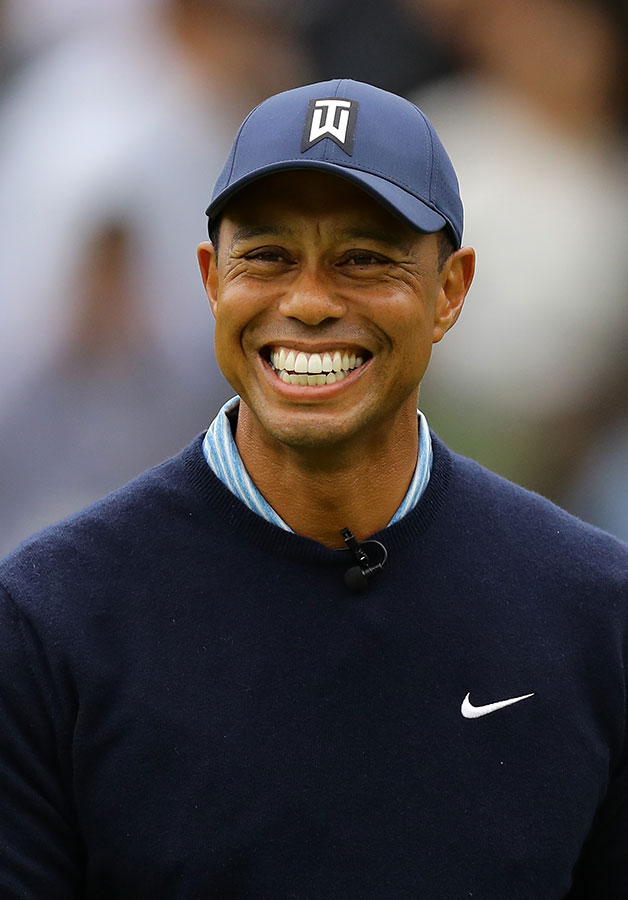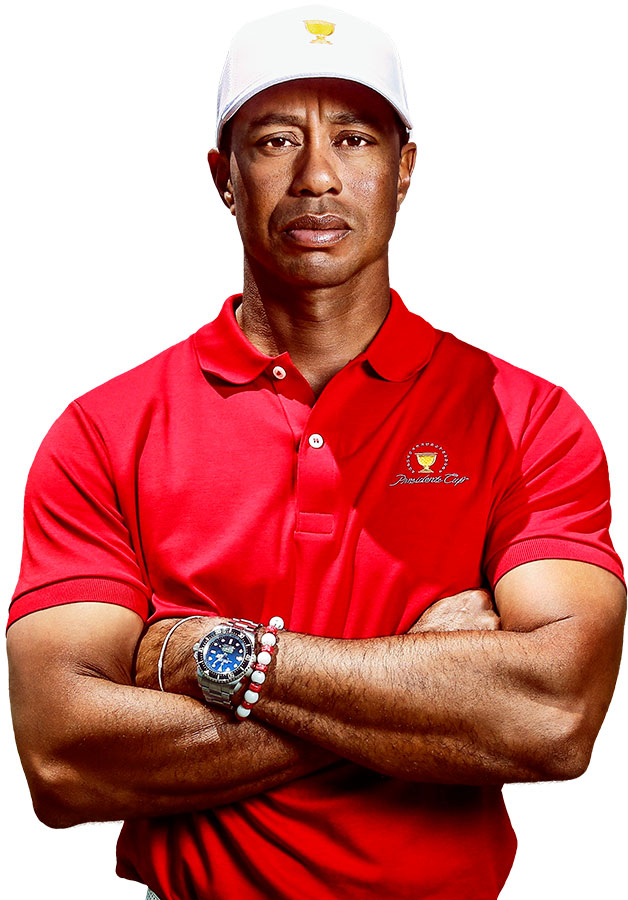The stage is set for the 13th edition of the Presidents Cup to be the best one yet: Tiger Woods lining up as a playing captain on a star-studded American team; a strong Australian contingent among a team of in-form International players; and, of course, the spectacular Royal Melbourne in December shape.
But this dream spectacle almost never happened.
PGA Tour commissioner Jay Monahan approached Woods prior to the 2017 Presidents Cup in New Jersey and asked if he wanted to captain the American side two years later. But Woods wasn’t interested. No, he was preoccupied with an involuntary retirement that had become increasingly likely after spinal fusion surgery. The world came awfully close to saying goodbye to one of the most brilliant and captivating careers in sports history.
However, Woods was already pencilled in to be a vice-captain at Liberty National. Despite battling his own demons, Woods did not want to let down close friend ‘Stricks’ – Steve Stricker – who was to skipper the Americans in 2017.
Once he was in the team environment and felt the unconditional support of younger players he had once inspired, Woods was rejuvenated. The impact the 2017 Cup had on Woods would ultimately launch him back to Major-winning form.
So, in early 2018, Woods went back to Monahan and accepted. Woods began to feel the excitement of returning to one of his favourite golf destinations in the world. He has always loved the surprises Sandbelt golf can throw up since first experiencing the revered region at the 1997 Australian Masters. He also recalls strolling the fairways of Kingston Heath during a practice round before winning the 2009 Australian Masters. As he putted out on 18 on the Tuesday, Woods was delighted when he discovered the round wasn’t quite over.
“I saw that little spare hole; the par 3 that’s 80 yards long,” Woods tells Australian Golf Digest with a smile. “We went over and, of course, I had to play it. I was like, ‘Gosh! Why can’t we play this during the tournament?”
 Australian Golf Digest: What’s the first thing you picture when someone says ‘Australia’?
Australian Golf Digest: What’s the first thing you picture when someone says ‘Australia’?
Tiger Woods: First thing? Kangaroo [laughs]. No, for me as a person who has gone down to Oz a lot, I love the fact that you guys are so into sport. The whole country, whatever sport it is, they support their country. Knowing all the Aussie guys over the years, the fact they have to travel so far to compete, that’s not easy to do. Just a simple thing like Tri Nations [rugby], you had to travel. For the golfers who have come over to the States to compete, it’s not easy to do and I have a lot of respect over the years for the guys who have done that. Whether it was Norman before me, or Peter Thomson before him, or ‘Finchy’ (Ian Baker-Finch) – you have to make a lot of effort to go around the world and play because it’s so far from home.
You’re heading back to Melbourne. What else do you love about the city?
Besides golf just being down in Melbourne. As I’ve always said, it’s a beautiful city and a sports-mad town. It’s been a lot of fun going down there. I’ve always had a good time staying down at the Crown. I think it’s going to be fun for the whole team.
What about Sandbelt golf appeals to you? You seem to love playing it when you’re there.
I do, because it’s a lot like my favourite golf, which is links golf. It’s firm, it’s fast, it’s hard and the ball bounces forward. You have to think about what you’re going to do and how the ball is going to bounce. Too often in the States, we put the ball straight up in the air and let it plug. In Oz, you have to chase the ball and anticipate whether it’s going to take a big hop when it gets to the green. That to me is fun and is how the game of golf should be played.
Has it influenced your course designs?
It has, no doubt. I design my golf courses very linksy or more towards the Sandbelt style, so you have a lot of room to run the ball and have it chase and try to get it on the ground where it wants to be. I don’t like golf in the air.
Your first time on the Sandbelt was the 1997 Australian Masters. What are your recollections of your Sandbelt debut?
I remember the seventh hole [at Huntingdale GC] being the tightest hole I had ever seen. Bushes on both sides and I had to figure out how I’m going to fit a driver down there. I ended up chickening out and hitting a 4-iron. I hit 4-iron, 4-iron, 4-iron into the wind. When I got a chance to play the British Open in 1995, that was my introduction to links golf – Carnoustie and St Andrews. I fell in love with that style of golf. Sandbelt golf is different, but it has very similar principles. To go down and play Huntingdale in ’97 was a little more narrow and quicker than Scotland. I just love that type of golf because you have to think about what you’re going to do off the tee, what you’re going to do into the green. Downwind, it’s impossible to get the ball close, which I think is great.
 What have you made of the Australian pros, as a group, over the years?
What have you made of the Australian pros, as a group, over the years?
They’re a close-knit bunch. They travel together to play on teams and represent their country. They grow up together playing junior golf or even when they come to the US to play collegiate golf. They’re tight, no matter where they are in the world. And you can always hear the accent! That’s one thing that definitely stands out.
How does the Australian Open return to its former glory?
Well, it’s hard now with the PGA Tour and its new season starting. It forces guys to play a little more early in the season, which is only two weeks after the previous season ends. So the guys are playing a lot towards the end of the year and that places a little strain on other places around the world. Now, we have three Asian events in a row and you’ll get some guys from Oz who will go down there and support the tour, but it’s a little more difficult now.
How important are the Australian players going to be for Ernie Els’ International team?
Well, they have always been an integral part of the teams, especially the two times the Cup has been down there. I just think, given the support of the home crowd, it is better to have more Aussies on the team. Hey, you have a pretty good core group of guys from Oz on the International team. You always have. Some of the best players in the world throughout golf’s history have been Australians. This will be no different.
How much fun was it to beat Greg Norman in 1998 at Royal Melbourne?
Well, the Cup was pretty much already over, because the Internationals absolutely boat-raced us. But to have the chance to go head-to-head against Greg in his home country was quite an honour and it was a lot of fun.
I got him on the 18th hole.
It’s not your only great memory from the Sandbelt. How much did you enjoy winning the Australian Masters at Kingston Heath by two shots in 2009?
God, it was so much fun because it was so fast. It was hard; there were a couple of holes where I had a 60-degree sand wedge and couldn’t get it close. I had to be smart and I stayed away from a lot of the flags.

Describe Jason Day as a person. He’s looked up to you since he was a child. How has it been to somewhat mentor him over the years?
Oh, he’s been a great dude. He has a big, huge heart. He wants to learn and wants to become better. He’s one of those guys who loves to rip you.
He ripped you during the Japan Skins match that he won in October.
He did, but I ripped him right back [laughs]. That’s how we’ve always been. He’s picked my brains over the years to try to become a better player and he’s tried not to reinvent the wheel. But I think from getting to know him and Col [Swatton] over the years, I’ve always loved being around Jason. He’s a great guy with a big heart.
Would you welcome a GOLFTV Skins challenge in Melbourne if the opportunity came up?
Playing in Oz is always fun, especially going down to Melbourne. I think it would be a nice addition to move it somewhere around the world, especially [Australia]. They always come out in droves and they would really support that event.



